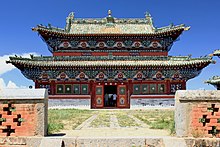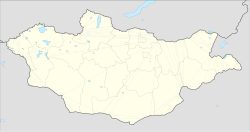Articles related to Mongolia include:

Altan Khan of the Tümed, whose given name was Anda, was the leader of the Tümed Mongols de facto ruler of the Right Wing, or western tribes, of the Mongols, and the first Ming Shunyi King (順義王). He was the grandson of Dayan Khan (1464–1543), a descendant of Kublai Khan (1215–1294), who had managed to unite a tribal league between the Khalkha Mongols in the north and the Chahars (Tsakhars) to the south. His name means "Golden Khan" in the Mongolian language.
Shankh Monastery located in Övörkhangai Province, Central Mongolia, 25 kilometers South East of Kharkhorin city, is one of Mongolia’s oldest and most historically significant monasteries. It was founded in 1647 by Zanabazar, the first Jebtsundamba Khutuktu, or spiritual head of Tibetan Buddhism for the Khalkha in Outer Mongolia, around the same time as the establishment of the nearby Tövkhön Monastery.

Buddhism is the largest religion in Mongolia practiced by 51.7% of Mongolia's population, according to the 2020 Mongolia census. Buddhism in Mongolia derives much of its recent characteristics from Tibetan Buddhism of the Gelug and Kagyu lineages, but is distinct and presents its own unique characteristics.

Karakorum was the capital of the Mongol Empire between 1235 and 1260 and of the Northern Yuan dynasty in the late 14th and 15th centuries. Its ruins lie in the northwestern corner of the Övörkhangai Province of modern-day Mongolia, near the present town of Kharkhorin and adjacent to the Erdene Zuu Monastery, which is likely the oldest surviving Buddhist monastery in Mongolia. They are in the upper part of the World Heritage Site Orkhon Valley.
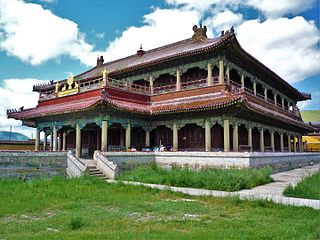
Amarbayasgalant Monastery or the "azzaya", is one of the three largest Buddhist monastic centers in Mongolia. The monastery complex is located in the Iven Valley near the Selenge River, at the foot of Mount Büren-Khaan in Baruunbüren sum (district) of Selenge Province in northern Mongolia. The nearest town is Erdenet which is about 60 km to the southwest.

Öndör Gegeen Zanabazar was the first Jebtsundamba Khutuktu and the first Bogd Gegeen or supreme spiritual authority, of the Gelugpa lineage of Tibetan Buddhism in Mongolia.
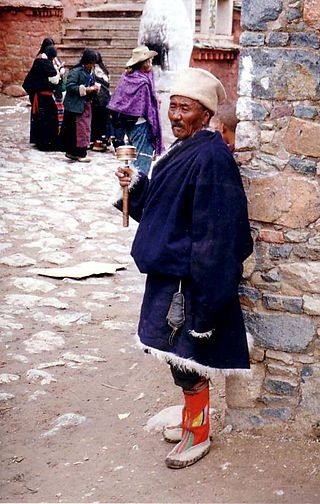
The most important places in Buddhism are located in the Indo-Gangetic Plain of southern Nepal and northern India. This is the area where Gautama Buddha was born, lived, and taught, and the main sites connected to his life are now important places of pilgrimage for both Buddhists and Hindus. Many countries that are or were predominantly Buddhist have shrines and places which can be visited as a pilgrimage.

Gandantegchinlen Monastery, also known as Gandan Monastery, is a Buddhist monastery in Bayangol District, Ulaanbaatar, Mongolia. It was founded in 1809, closed amid persecutions in 1939, and from 1944 to 1989 was the country's only active monastery. Today, it is the center of Buddhism in Mongolia. The monastery has more than 100 resident monks and numerous Buddhist treasures, including a 26-metre (85 ft) statue of Avalokiteśvara made of gilded bronze and precious stones.

Kharkhorin is a town and sum (district) center in Övörkhangai Province in Mongolia. The sum population was 13,828 (1994), 13,964 (2000), and 14,765 (2017). The population of Kharkhorin town itself was 14,765 in 2017 and covered an area of 20.5 km2.

The architecture of Mongolia is largely based on traditional dwellings, such as the yurt and the tent. During the 16th and 17th centuries, lamaseries were built throughout the country as temples which were later enlarged to accommodate a growing number of worshipers. Mongolian architects designed their temples with six and twelve angles and pyramidal roofs approximating the yurt's round shape. Further expansion led to a quadratic shape in the design of the temples, with roofs in the shape of pole marquees. Trellis walls, roof poles and layers of felt were eventually replaced by stone, brick beams and planks.

The 9th Jebtsundamba Khutughtu was the 9th reincarnation of the Jebtsundamba Khutuktu, the third highest lama in the Tibetan Buddhism hierarchy and the spiritual leader of the Gelug lineage among the Khalkha Mongols. Although recognized as the reincarnation of the Bogd Khan in 1936, his identity was kept a secret by the Dalai Lama until 1990, due to the persecution of the Buddhist religion by the Communist Mongolian People's Republic, and he did not reside in Mongolia until the final year of his life.
There is a small Mongolian community in India, comprising mostly Buddhist monks and scholars as well as international students from Mongolia.
Works of sculpture have been crafted in Mongolia since prehistoric times. Bronze Age megaliths known as deer stones depicted deer in an ornamented setting. Statues of warriors, the Kurgan stelae, were created under Turkic rule from the 6th century CE, and later started to bear inscriptions in a phonetic script, the Orkhon script, which were deciphered only in the 1980s. Warrior statues continued under the Uighurs, who also made a gold image of the Buddha. Many examples of sculptures of people and animals, as well as carved stelae, are known from the Mongol Empire, especially from its capital Karakorum.
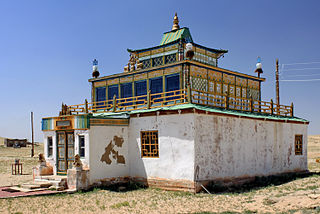
Khamar Monastery, founded in 1820, was an important Red Hat sect Buddhist monastic, cultural, and education center in Mongolia’s Gobi Desert region until its destruction in 1937. It was rebuilt in 1990. Today it is located in Khatanbulag district, Dornogovi Province, approximately 47 km south of the provincial capital Sainshand. At its height, the monastery reportedly accommodated over 80 temples and some 500 monks.

Tövkhön Monastery, one of Mongolia's oldest Buddhist monasteries, is located in Övörkhangai Province, Mongolia, about 47 km (29 mi) southwest of Kharkhorin.
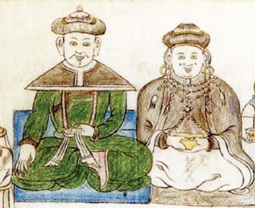
Abtai Sain Khan - alternately Abatai or Avtai (Mongolian: Автай хан, meaning who have the gift of witchcraft and good - was a Khalkha-Mongolian prince who was named by the 3rd Dalai Lama as first khan of the Tüsheet Khanate in 1587. He zealously propagated Tibetan Buddhism among the Khalkha Mongols and founded the Buddhist monastery of Erdene Zuu in 1585.

Tüsheet Khan refers to the territory as well as the Chingizid dynastic rulers of the Tüsheet Khanate, one of four Khalka khanates that emerged from remnants of the Mongol Empire after the death of Dayan Khan's son Gersenji in 1549 and which continued until 1930.
